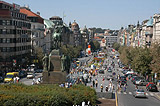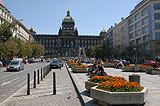Albert Einstein lived in Prague as well
Nov 29, 10:18 Filed under history
 Did you know that Albert Einstein himself was in Prague? The famous German-born American theoretical physicist widely regarded as the most important scientist of the 20th century and one of the greatest physicists of all time was walking the streets of Prague some 95 years ago! He did not only visit Prague, he actually worked here!
Did you know that Albert Einstein himself was in Prague? The famous German-born American theoretical physicist widely regarded as the most important scientist of the 20th century and one of the greatest physicists of all time was walking the streets of Prague some 95 years ago! He did not only visit Prague, he actually worked here!
Later Nobel Prize winner in Physics, Albert Einstein, came to Prague in 1911 when he was 31 with his family – his wife Mileva and two sons, Hans Albert (7 years) and Eduard (1 year). Einstein was appointed a full professor at the German University in Prague. He held lectures about mechanics and kinetic heat theory.
A new flat was built for Einstein and his family in the Prague district Smichov. They lived in Lesnicka 7 at the left bank of the Vltava River. But Einstein spent most of his free time in the salon of Mrs. Bertha Fanta on the Old Town Square where a debating circle met regularly. Famous participants apart from Einstein here were writers Max Brod and Franz Kafka. Einstein liked coming here with his violin and between literary discussions he took part in musical events to entertain his friends.
Einstein’s years in Prague are an important milestone in the life of this important researcher and philosopher. In Prague Albert Einstein found – according to his own writings – the necessary composure to give the basic thought of the general theory of relativity (1908) a more definite shape. During his 17-month lasting stay in Prague, Einstein wrote 11 scientific works, 5 of them on radiation mathematics and on quantum theory of the solids.
You can visit the place where famous Albert Einstein played his violin. Look for a memorial plaque outside a house on the Old Town Square. It reads:
“Here in this salon of Mrs Berta Fanta, Albert Einstein, Professor at Prague University in 1911 to 1912, founder of the theory of relativity, Nobel Prize Winner, played the violin and met his friends, famous writers, Max Brod and Franz Kafka.”


